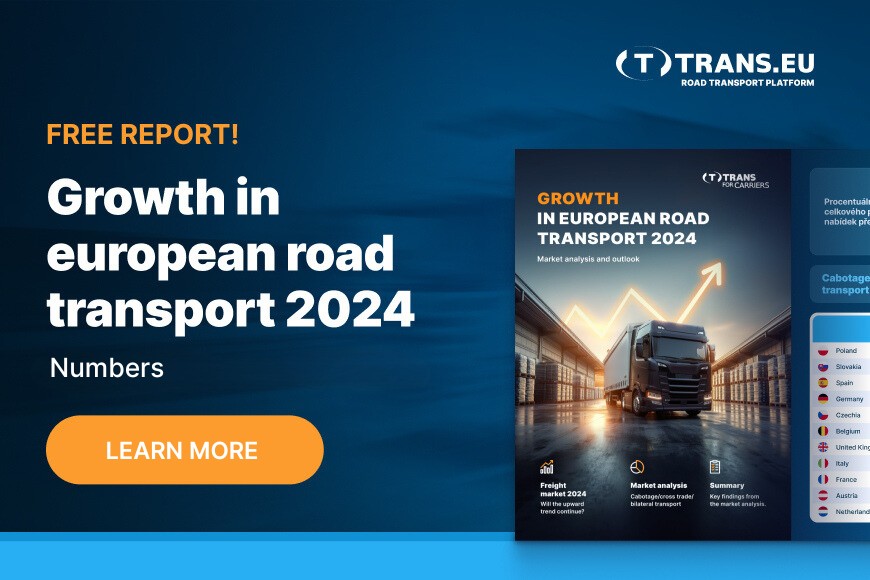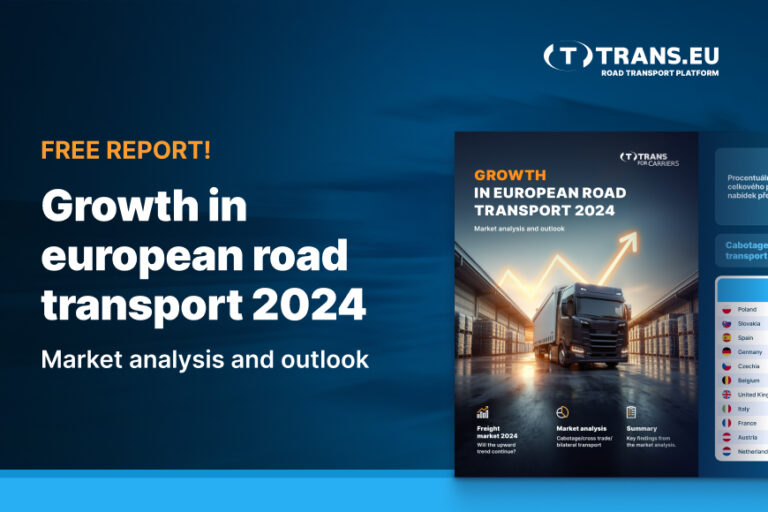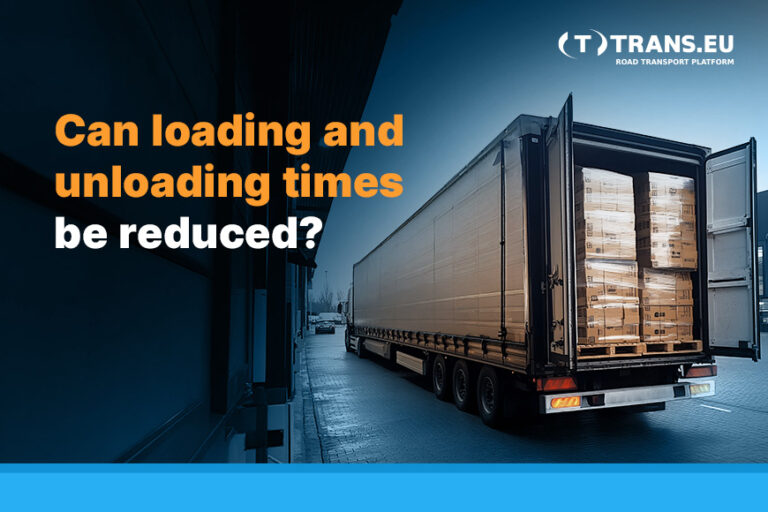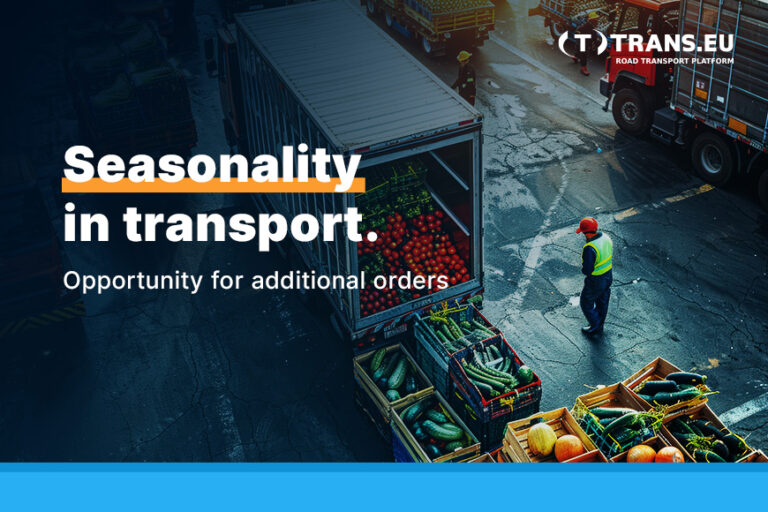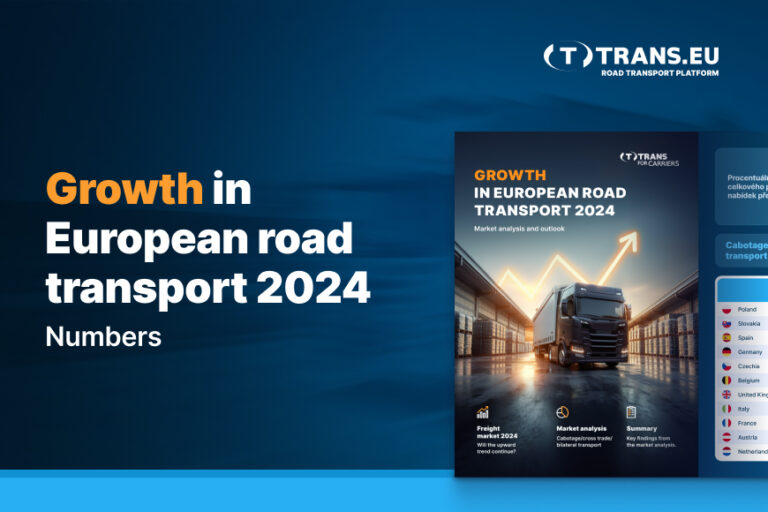Transport market 2024. Will the upward trend continue?
Maciej Wroński, President of the employers’ association “Transport and Logistics Poland” has long been talking about the so-called European Banana, i.e. the most urbanized area of Europe, where continental industrial production is concentrated. It is an area stretching from Manchester in Great Britain to Milan in Italy – resembling the shape of a banana. (The original term for the most urbanized area of Europe was the Blue Banana, first used by the French geographer Roger Brunet in 1989).
The European Banana covers Southern UK, Benelux, Western Germany, Eastern France, Switzerland and Northern Italy. As Wroński argues, if industrial production in these countries is falling, it is simply necessary to reduce the fleet, and not to think about other markets, because there are simply no alternatives.
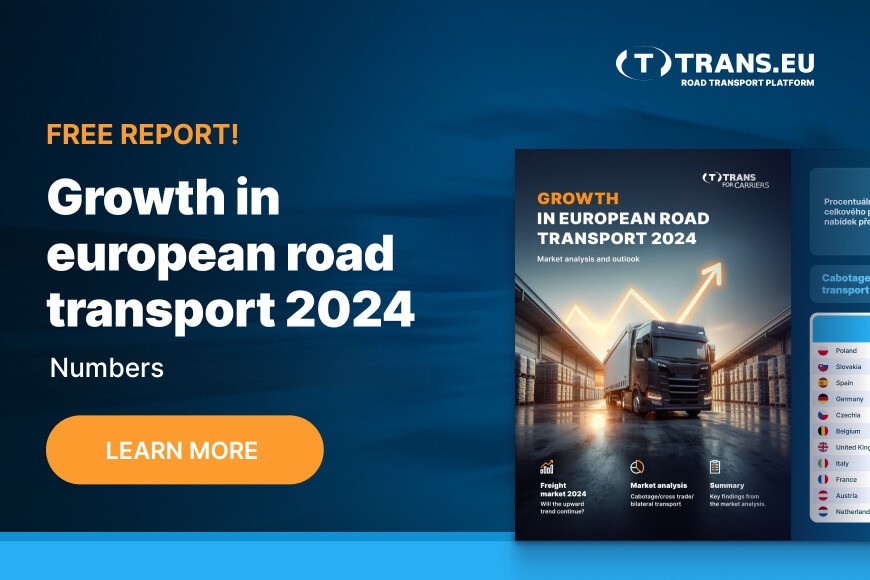
Industry under the line
It’s hard to argue with that, because indeed industry performance across almost all of Europe (excluding services) is still at a low level, which has been causing a drastic drop in transport orders and freight rates for more than a year. In June this year, the manufacturing PMI in the Eurozone amounted to 45.6 points, which means that the recession continues. The European Commission’s so-called spring forecast predicts GDP growth in 2024 to be 1.0% in the EU and 0.8% in the eurozone. In a word, the macroeconomic parameters do not yet indicate a significant economic recovery, but rather a slow emergence from the recession.
However, transport is sensitive to any changes in the economy and reacts almost immediately. Even if we assume that a certain percentage of orders are duplicated by forwarders, it is difficult to deny the steady upward trend for several months. It seems that the transport industry is trying to diversify the directions of transport more than before, not just focusing on the Blue Banana. Therefore, in transport orders on the Trans.eu Platform, there are many increases in directions that are not always obvious.
It is not surprising that there is an increase in the number of freights from Belgium to Germany (83%), from France to Belgium (85%), from Germany to Austria (65%), or from the Netherlands to Germany (68%). Despite the poor performance of the European industry, even modest economic growth is immediately felt among carriers. In addition, the increase in orders in these traditional directions is undoubtedly influenced by the growing turnover of the largest European transshipment ports in Antwerp in Belgium and Rotterdam in the Netherlands (which is actually pleasing, because it gives more work to road carriers). Cabotage operations on these traditional routes also show a strong upward trend.
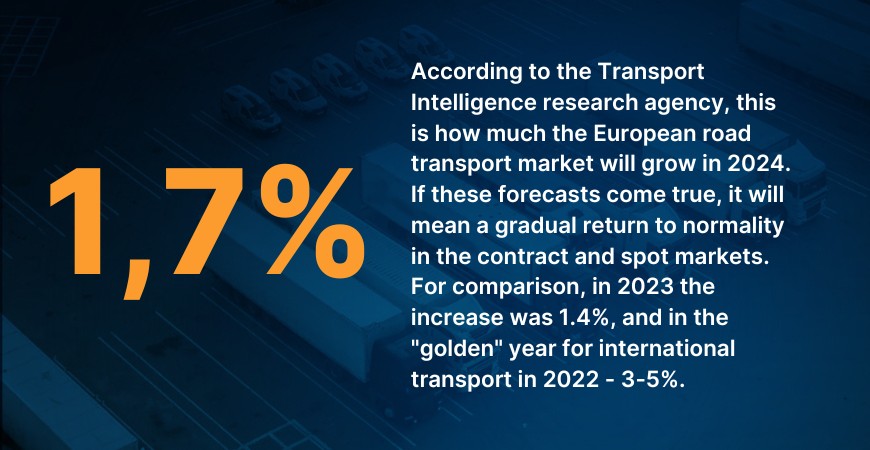
Wave of bankruptcies
In addition, the seasonality of some orders is also a determining factor, yet the Netherlands is one of the world’s largest producers of vegetables and is particularly dominant in greenhouse horticulture. Dutch onions, tomatoes, sweet peppers and cucumbers go primarily to Germany, but also to Benelux and other European countries.
However, the higher number of shipments on some routes, such as Slovakia, the Czech Republic or Hungary, is difficult to explain rationally, as nothing has happened in these countries that could contribute to the increases. But as experts point out, the attractiveness of European routes needs to be considered holistically, and all our interlocutors pay attention to it.
The transport market has seen a decline in the number of available vehicles, which resulted in an increase in the number of offers transferred to the spot market from over-the-counter trading. We are observing a wave of bankruptcies of transport companies, which directly affects the number of trucks ready to take up the load. Rafał Jabłoński, CEO at System Transport, a transport and logistics company.
The situation is completely different in Croatia, which is often visited by carriers from Poland and Italy. The Croatian economy has grown by 16% since just before the pandemic (2019-2024). This is the most dynamic growth among the members of the European Union. Importantly, thanks to the funds from the EU National Recovery and Resilience Plan, the construction industry, which is always the driving wheel of any economy, is developing there. But it seems that the greatest impact on the recovery of transport was the accession of Croatia to the Schengen Area in 2023 and the lack of customs controls at the border. It should also be added that Croatia adopted the euro in the same year.
Carriers are looking for new routes
What do representatives of the TSL sector think about the current situation on the transport market? How do they cope with this complex situation?
There are fewer vehicles in the market, hence the probably greater recovery on the exchange. We travel in traditional directions – to Germany, the Netherlands and France, but we also use transport to other countries, where freight rates allow us to achieve at least a small margin. For example, we often go to Austria, Italy and Switzerland because you can earn a little more there. In Switzerland, the rate is decent enough that it pays for us to take the order, despite burdensome customs control and high tolls. Karolina Urbanik, branch manager of the DM Logis transport company in Poznań.
For carriers from Central and Eastern Europe – mainly Poles, but also Lithuanians, Czechs, Romanians and Bulgarians, cabotage and cross trade towards Italy also seem attractive. Why is there such a rebound in contract and spot orders? For the same reason as in other markets: a decline in the availability of vans and trucks. (Vans on the France-Italy route – up by almost 6%). Yet, Italy also has its own additional peculiarity: road inspection and police checks often end up with vehicles driven by Ukrainian or Belarusian drivers with a Polish driver’s license but a driver’s card from their home country being put on hold. Thus, the Italian restrictions have further reduced the availability of vehicles in the Italian market.
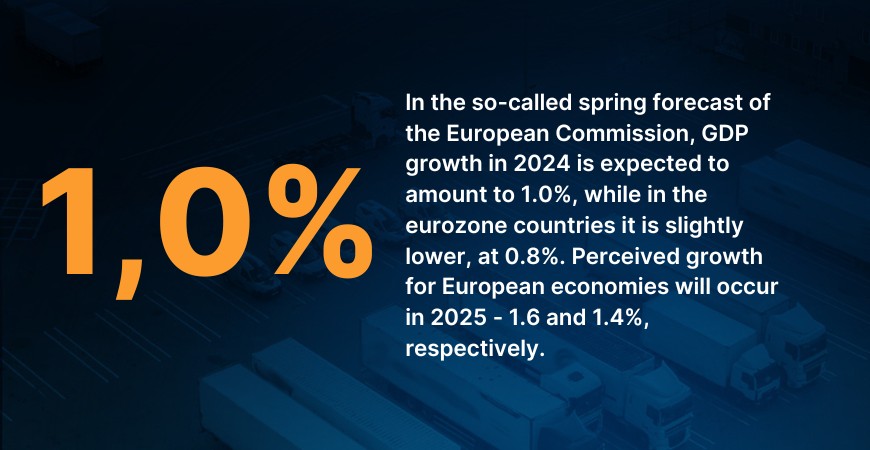
However, as experts add, in southern European countries – such as Italy, Spain and Portugal – the coming months may be characterized by a decrease in the number of orders. The reason is prosaic: the holiday season in companies is starting there, so it will be difficult to bring or export anything. A recovery in Southern Europe is not expected until late September at the earliest.
From contracts to spot
“We see a certain breakthrough in the market, a slight increase in offers and higher freight prices on some routes. But this market is still pathological, shippers most often want us to drive below cost. This is slowly starting to change, as transport companies no longer have the capital to cover losses and often pull out from unprofitable routes. Thus, they move from the contract market to the spot market, where they seek better money. The facts are that the costs of doing business are getting higher and freight rates are growing disproportionately slower, comments Marcin Juszczak, head of the Gdynia branch of Connect Logistics.
The transport business is strongly related to fluctuations in fuel prices. Fortunately, for the sector as a whole, fuel costs – despite the energy crisis in Europe and the abandonment of Russian oil – have remained stable for more than a year. This may change, however. According to analysts at investment Goldman Sachs, in 2024 the price of a barrel of oil is likely to fluctuate between $70 and even $100 (it currently averages $80). If the price of fuel rises on global exchanges, the wholesale price of diesel will rise, increasing costs for carriers. And the pressure on shippers to raise freight rates.
“The rebound in the market is noticeable, but the volume of freight and prices from a good year 2022 is still a long way off. Like most of my friends in the industry, I doubt that those rates will ever come back. Today, many, including large transport companies, are undergoing restructuring, so there are fewer vehicles in the market. However, shippers are reluctant to talk about raising rates. I have the impression that we can expect some noticeable change only in the last quarter of this year,” says Adam Kmoch, Operations Director at Eltrans.
The company travels all over Europe, including Switzerland, the Benelux countries, England, Ireland, as well as Scandinavian countries and even Belarus. It uses only cold storage and serves the pharmaceutical market. “We work on the hermetic market of transporting medical products and try to keep the level of freight prices. And we simply say “no, thanks” to customers who expect us to operate with a small margin,” he adds.
Eyes set on Germany
The most important thing for carriers is the macroeconomic information coming out of the European economies. And these, as we mentioned earlier, are not encouraging so far. The prestigious research agency Transport Intelligence forecasts in its report that in 2024 the European road transport market will grow by 1.7%. However, a lot depends on the situation in the Blue Banana. The United Kingdom, just like Germany, has already emerged from the technical recession and is rising from its knees (0.6% GDP growth in the last quarter), but France is growing slower than expected (forecast at 1.0% in 2024).
The economic situation in Germany is of key importance for international transport. However, the German locomotive is accelerating very slowly, last year it recorded a sharp slowdown (negative economic growth for 2 consecutive quarters). According to the so-called summer forecast of the prestigious Kiel Institute for the World Economy (IfW Kiel), Germany is currently experiencing a moderate economic recovery. Industrial production is expected to grow by 0.2% this year, with the recovery driven mainly by exports and domestic consumption.
However, this is still not much. According to the Kiel institute, a noticeable recovery in the economy – and this is also confirmed by the German Council of Economic Experts – is not expected until 2025, with growth of around 1.1%. (Inflation, which is already low, is expected to stabilise at 2% in 2025). “The nascent growth is gaining strength, like a football team fighting for promotion after a long time in defense,” says Professor Stefan Kooths, head of forecasting at IfW Kiel. From the point of view of the neighbouring economies (and the transport market), the development of the automotive sector is particularly important, as it provided jobs to hundreds of subcontractors from outside Germany. Unfortunately, here the growth is hampered by strong Chinese competition.
The German transport market continues to adapt to the high tolls introduced at the beginning of December 2023. It is difficult for transport companies to compete in the European market with carriers from Eastern Europe. The market pressure is enormous. We do not have universal European diesel prices and taxes, and the wage gap between Germans and Eastern European companies is also a significant factor. Many competing companies use price dumping and carry out illegal cabotage transport. Philip Beushausen, spokesman for the Bundesverband Güterkraftverkehr Logistik und Entsorgung (BGL)
European economies are slowly recovering from their dormancy, and so is the transport market. Manufacturers and distributors will soon have to accept higher freight rates. This is the law of supply and demand. Some carriers are just disappearing from the market and selling their fleet, which inevitably generates greater demand for transport services. Is normality returning? Let’s hope so.
To see the data and statistics go to: Growth in European road transport 2024. Numbers
